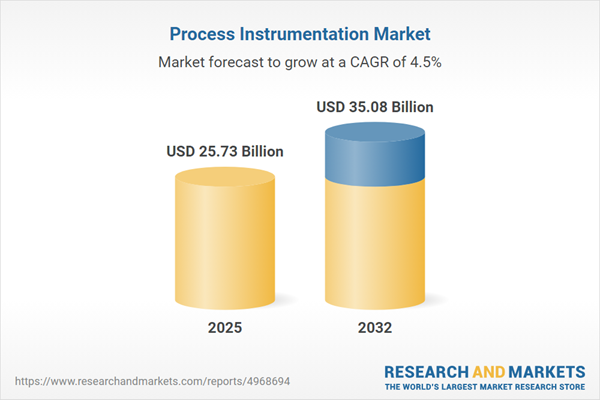Speak directly to the analyst to clarify any post sales queries you may have.
Process instrumentation is reshaping industrial operations, empowering organizations to achieve smarter measurement, robust control, and streamlined decision-making. As business complexity increases, executive teams face urgent needs for actionable insights into technology adoption, market segmentation, and regulatory change throughout the global process instrumentation market.
Market Snapshot: Process Instrumentation Market
The process instrumentation market expanded from USD 24.59 billion in 2024 to USD 25.73 billion in 2025, with expectations to reach USD 35.08 billion by 2032 at a CAGR of 4.53%. Continuous digitization and evolving regulatory environments are prompting industries such as manufacturing, energy, and resources to update operational methods. The focus on process optimization and analytical tools allows organizations to reduce risk, increase efficiency, and improve compliance strategies in the face of mounting industry competition.
Scope & Segmentation of the Process Instrumentation Market
- Instrument Types: Analytical instruments (conductivity meters, gas analyzers, pH meters, spectrophotometers) support critical monitoring, while control valves, positioners, and equipment measuring flow, level, pressure, and temperature drive precision in diverse process environments.
- Mounting Types: Clamp-on, immersion, inline, and insertion solutions offer flexible installation, adapting to the operational requirements and infrastructure constraints at facilities of all scales.
- Technologies: Electronic and mechanical products address foundational process needs. Smart devices—digital, IIoT-enabled, self-diagnostic, and wireless—enable predictive maintenance, real-time monitoring, and data-driven workflow optimization, helping companies transition to Industry 4.0 standards.
- End Use Industries: These solutions reinforce process integrity in chemicals (agrochemical, basic, specialty), food and beverage, metals and mining, oil and gas (covering upstream, midstream, downstream), pharmaceuticals, power (renewable, thermal, nuclear), and water and wastewater sectors (both industrial and municipal applications).
- Regional Coverage: The market spans the Americas—including North America (United States, Canada, Mexico) and Latin America (Brazil, Argentina, Chile, Colombia, Peru); Europe, Middle East, and Africa (countries such as the United Kingdom, Germany, France, Russia, Saudi Arabia, South Africa, and more); as well as Asia-Pacific (featuring China, India, Japan, Australia, South Korea, Indonesia, Thailand, Malaysia, Singapore, Taiwan).
- Leading Companies: Industry leaders—such as Emerson Electric Co., ABB Ltd, Siemens AG, Schneider Electric SE, Yokogawa Electric Corporation, Honeywell International Inc., Endress+Hauser Group Services AG, Danaher Corporation, Rockwell Automation Inc., and Azbil Corporation—deliver comprehensive hardware, software, and integration services supporting customer-specific process improvement objectives.
Key Takeaways for Senior Decision-Makers
- The convergence of operational and information technologies is creating new opportunities for predictive maintenance, enhancing proactive service, and supporting in-process quality assurance across multiple sectors.
- Distinct operational challenges in fields such as oil and gas or pharmaceuticals highlight the need for instrumentation built for demanding or sensitive environments, promoting reliability and regulatory compliance strategies.
- Wireless and IIoT-enabled devices are driving remote monitoring capabilities, supporting risk mitigation and enhancing safety protocols in hazardous or hard-to-reach locations.
- Flexible and modular architectures allow organizations to quickly adapt to changing regulatory requirements and operational priorities, supporting both short- and long-term strategic objectives.
- Integrated hardware-software ecosystems are enabling vendors to offer outcome-based services, extending asset lifespans and delivering ongoing value to end users through improved productivity and reliability.
- The growing importance of sustainability and decarbonization influences investment and procurement decisions, prompting increased focus on optimizing resource use while meeting worldwide regulatory mandates.
Tariff Impact on Global Supply Chains
Recent changes in United States tariffs have led companies to reassess sourcing and supply chain models within the sector. This shift is intensifying moves toward supplier diversification, nearshoring, and modular platform development—all aimed at managing financial risk and operational resilience. Collaboration has increased between manufacturers, integrators, and local service providers, reinforcing the market’s ability to withstand geopolitical and logistical disruptions.
Process Instrumentation Market Research Methodology & Data Sources
This report applies primary research—such as interviews and surveys with sector stakeholders—alongside secondary analysis covering technical literature, regulatory frameworks, and patent reviews. An emphasis on validation and peer review maintains the accuracy and practical relevance of findings, while advanced analytical modeling supports robust scenario planning and strategic foresight.
Why This Report Matters
- Offers in-depth segmentation and regional intelligence to empower informed investment, procurement, and operational decisions across multiple geographies.
- Assists executive teams in aligning digital transformation and sustainability objectives with evolving regulations and operational best practices.
- Supports benchmarking, growth opportunity identification, and risk mitigation to enhance organizational resilience in dynamic global markets.
Conclusion
This report equips senior leaders to face technological, regulatory, and operational change with confidence. It provides clarity for strategic planning and supports the pursuit of efficiency and resilience across the global process instrumentation market.
Additional Product Information:
- Purchase of this report includes 1 year online access with quarterly updates.
- This report can be updated on request. Please contact our Customer Experience team using the Ask a Question widget on our website.
Table of Contents
3. Executive Summary
4. Market Overview
7. Cumulative Impact of Artificial Intelligence 2025
List of Figures
Samples

LOADING...
Companies Mentioned
The key companies profiled in this Process Instrumentation market report include:- Emerson Electric Co.
- ABB Ltd
- Siemens AG
- Schneider Electric SE
- Yokogawa Electric Corporation
- Honeywell International Inc.
- Endress+Hauser Group Services AG
- Danaher Corporation
- Rockwell Automation, Inc.
- Azbil Corporation
Table Information
| Report Attribute | Details |
|---|---|
| No. of Pages | 193 |
| Published | October 2025 |
| Forecast Period | 2025 - 2032 |
| Estimated Market Value ( USD | $ 25.73 Billion |
| Forecasted Market Value ( USD | $ 35.08 Billion |
| Compound Annual Growth Rate | 4.5% |
| Regions Covered | Global |
| No. of Companies Mentioned | 11 |









